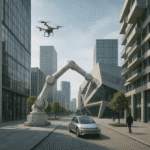Exploring the frontiers of human habitation beyond Earth demands a radical rethinking of architectural principles. Lunar and Martian environments challenge conventional **sustainability**, demand **resilience** against harsh conditions, and drive innovations that reshape our vision of **interplanetary** communities. This article delves into the design, materials, and technologies that will transform barren landscapes into thriving habitats.
Designing for the Moon: Materials and Environment
The lunar surface presents unique constraints: extreme temperature swings from -173°C to 127°C, abrasive dust known as regolith, and solar and cosmic **radiation** unshielded by any atmosphere. Architects and engineers must craft structures that can withstand these factors while remaining resource-efficient. Key considerations include:
- Regolith Utilization: Local soil can be sintered or melted into durable bricks, reducing launch mass.
- Thermal Insulation: Multi-layered shells with vacuum gaps and reflective films to manage heat flux.
- Radiation Shielding: Regolith-packed walls or water-filled compartments to absorb harmful particles.
- Pressurized Interiors: Flexible, airtight membranes that maintain comfortable living conditions.
In-Situ Resource Processing
Turning the Moon’s raw materials into building blocks involves robotics and **automation**. Autonomous rovers excavate and sort regolith, feeding it into 3D printers that create habitats layer by layer. This approach leverages advanced AI algorithms to adapt to changing terrain and ensure structural integrity.
Modular Habitat Concepts
Modularity allows lunar settlements to expand organically. Standardized inflatable modules can be airlifted, then covered with regolith for protection. Each unit serves as living quarters, laboratories, or agricultural pods, interlinked by pressurized corridors. The modularity reduces construction risk and enables incremental growth.
Martian Urbanism: From Habitats to Cities
Mars presents a lower gravity field (38% of Earth’s), a thin CO₂-rich atmosphere, and surface radiation levels similar to those in orbit. Over decades, settlements may evolve from isolated shelters to city-scale complexes. Designing for this transition involves:
- Subsurface Integration: Embedding structures in lava tubes or excavated caverns for natural protection.
- Greenhouse Networks: Transparent domes cultivating crops using artificial lighting and hydroponics.
- Shielded Skylines: Dome clusters linked by breathable tunnels, each coated with Martian dust.
Urban Planning Under Low Gravity
**Extraterrestrial** urbanism challenges architects to consider mobility, safety, and social dynamics in reduced gravity. Public spaces incorporate gentle slopes and magnetic footwear rails to prevent unintended floating. Central plazas with controlled environments encourage gatherings, while multi-level farms maximize vertical space.
Terraforming Foundations
Long-term visions of Mars include atmospheric modification. Deploying solar mirrors and greenhouse gas emitters could warm the planet and thicken its air. Although full-scale terraforming remains speculative, architectural designs must be adaptable, allowing habitats to transition from sealed modules to open-air structures as the climate evolves.
Advanced Technologies: 3D Printing and Autonomous Construction
Cutting-edge fabrication techniques are pivotal for constructing off-world habitats at scale. Key technologies include:
- Robotic 3D Printers: Laser or microwave sintering systems that fuse regolith into robust structural elements.
- Self-Deploying Robots: Swarm robotics capable of assembling frames and membranes without direct human oversight.
- AI-Driven Optimization: Machine learning algorithms that refine designs in real-time to account for material imperfections.
Bioregenerative Life Support
Closed-loop ecological systems will recycle air, water, and waste. Algae bioreactors convert CO₂ into oxygen, while aquaponics integrates fish farming and hydroponic plant growth. This **bioregenerative** approach enhances **sustainability** and reduces reliance on Earth-based resupply missions.
Smart Materials and Adaptable Facades
Innovations in **modularity** extend to materials that respond to environmental stimuli. Photochromic coatings adjust solar reflectivity, while shape-memory alloys enable dynamic structural reconfiguration. These **smart materials** help maintain optimal interior climates and extend the lifespan of habitats.
The Human Factor: Psychology and Adaptation
Beyond engineering challenges, the mental health and social well-being of inhabitants are paramount. Isolated crews face confinement, limited social interaction, and extreme environments. Architectural solutions must foster a sense of community and purpose.
- Biophilic Design: Integrating simulated natural elements—virtual windows, plant walls, and light cycles—to combat sensory deprivation.
- Flexible Communal Spaces: Multipurpose rooms for exercise, recreation, and meetings, adaptable to crew needs.
- Privacy Pods: Personal quarters engineered for solitude, featuring customizable lighting and soundscapes.
Psychological Resilience Strategies
Training in confinement analogs on Earth, such as polar stations, informs habitat design. Modules incorporate features that reduce stress: adjustable ambient color schemes, noise-dampening surfaces, and ergonomic furnishings. Virtual reality systems offer simulated Earth-like environments, providing mental respite and entertainment.
Community Governance and Culture
Establishing social norms, decision-making protocols, and cultural identity within off-world settlements is vital. Common areas feature shared artworks, digital libraries, and spaces for ceremonies. This emphasis on collective expression strengthens communal bonds and supports mission objectives.
Conclusion
Advancing from concept to reality will require interdisciplinary collaboration among architects, engineers, biologists, psychologists, and policy makers. The vision of **interplanetary** habitats hinges on leveraging local resources, pioneering **automation**, and fostering human **resilience**. As we push the boundaries of what is possible, lunar and Martian architecture will not only secure our future in space but inspire transformative innovations on Earth.










